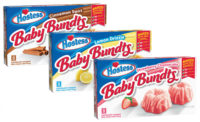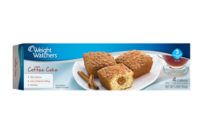They’re wedding cake stand-ins, they’re topped with everything from sweet breakfast cereal to bacon, and they’re popping right off the breakfast plate and onto restaurant menus nationwide. It’s safe to say designer doughnuts are having a moment.
Overview | Bread | Tortillas | Sweet Goods | Snack Cakes | Pizza | Desserts | Cookies | Buns & Rolls | Bars | Breakfast Products
According to Datassential, doughnuts are the top-growing dessert on restaurant menus over the past four years, jumping 66 percent in popularity. Cinnamon rolls and muffins were next in line, clocking in at 45 percent and 36 percent growth, respectively.
Market data
Every primary retail segment of sweet goods saw growth over the past year. According to data from IRI, Chicago, sales of the pastry/doughnuts category grew by 4.2 pastry/Danish/coffee cakes grew by 4.16 percent to $5.0 billion for the 52 weeks ending March 19, 2017. The top segment in the category, pastry/Danish/coffee cakes, grew by 3.44 percent to $2.0 billion. Doughnuts are a tight second in the category, $6.2 million behind pastry, and grew 2.89 percent to reach about $2.0 billion. Muffins round out the category and grew 8.45 percent to $977.7 million.
Private label leads every segment in sweet goods, and pastry/Danish/coffee cakes saw dollar sales grow by 14.08 percent to $393.1 million. Grupo Bimbo and Flowers Foods also both saw decent growth, up 5.85 and 5.44 percent, respectively.
In doughnuts, just after segment leader private label, the top performer was Hostess Brands, whose offerings reached $365.5 million in sales and grew 9.37 percent. Krispy Kreme also saw nice growth, up 8.66 percent to $259.8 million.
“Growth in doughnuts is particularly reliable,” says David Moline, sales and marketing manager, Moline Machinery, Duluth, MN. “Bakers are installing higher-volume, more-efficient production systems than ever before, which leads to better profitability for the commodity product variations, such as standard glazed and sugar doughnuts. Premium offerings—enrobed, filled, candy-topped, etc.—are also driving consumers to keep coming back to doughnuts more than ever before.”
Muffins are also growing at a significant clip. Private label dollar sales increased by 13.86 percent for the year, per IRI, up to $314.0 million. Top branded baker Grupo Bimbo, which owns the Entenmann’s brand, saw muffin dollar sales grow by 11.19 percent to $298.8 million. ARYZRA and its muffin brand Otis Spunkmeyer grew by 10.54 percent to $48.8 million.
According to David Guilfoyle, group manager, bakery, fats and oils, DuPont Nutrition & Health, New Century, KS, muffins appeal for a variety of reasons. First, they can be made sweet or savory, opening the door to a variety of flavor options. Second, they’re perfect for on-the-go breakfast or snacking. “And as consumers seek lower-sugar options, a savory muffin can also provide a filling choice with added protein and fiber,” he says. “Both sweet and savory muffins can also be morphed with ethnic flavors, which is a major trend in 2017.”
Looking back
Guilfoyle says trends in coffeehouses and doughnut chains are similar to those in in-store bakeries, with both finding success in new and unique flavor profiles, as well as sweet/salty varieties. The best time to take a chance with innovative flavors, though, is with seasonal offerings.
At Dunkin’ Donuts, seasonal varieties are a hallmark of their business model. For example, Dunkin’ Donuts introduced a Shamrock Sprinkle Donut (a ring doughnut frosted with chocolate icing and topped with shamrock sprinkles) alongside a Vanilla Truffle Donut (filled with vanilla flavored buttercream, frosted with chocolate icing, and topped with white and dark chocolate curls) in March 2017. Dunkin’ Donuts took a shot at the popular “cronut” for its holiday 2016 menu, offering a Boston Kreme Croissant.
Seasonal offerings are also a cornerstone at Flowers Foods, Thomasville, GA, the parent company behind Tastykake and Mrs. Freshley’s. Tastykake offered Pumpkin Spice Mini Donuts for fall 2016 and Gingerbread Mini Donuts for the winter. “Not only do seasonal flavors generate consumer interest,” says Brent Bradshaw, vice president of marketing, cake, “but they also transform a traditional breakfast item into a delicious, anytime snack.” Bradshaw credits coffeehouses and doughnut chains with popularizing limited-edition items. “It’s clear that consumers today expect to have a variety of choices, and to keep them interested, these choices have to constantly change.”
Krispy Kreme has also experimented with co-branded products, offering new Ghirardelli doughnuts, in Mint Chocolate and Sea Salt Caramel, launched in April 2017.
Guilt-free—or reduced guilt—is also a trend that’s influenced this category over the past year. Patricia Kennedy, president of WP Bakery Group, Shelton, CT, is seeing this trend take shape in the form of miniature offerings which “reduce any feeling of guilt involved with consuming sweet products, and are a convenient snack.”
Of course, one other way to reduce guilt for consumers is to offer them a clean or healthier label. The challenge, says Guilfoyle, is that many bakeries are moving from direct-to-store deliveries to warehouse distribution models and, with that, “there is a challenge between extending shelf life and keeping bakery products clean label.” The solution, he says is to focus on three goals: retaining moisture, protecting against microbes and meeting antioxidant requirements that keep the products fresh. Meeting all of these goals is daunting, though, while also keeping a product clean label.
To that end, DuPont Nutrition & Health offers several clean-label options for food protection. Its Natamax ingredient uses a natural antimicrobial, natamycin, to keep sweet goods from spoiling. “Natamycin has been used in the dairy industry for years,” Guilfoyle adds, “protecting processed and shredded cheese from spoiling during shelf life.”
Parker Products, Fort Worth, TX, is helping manufacturers meet clean label demands with its praline nuts—suited for use as inclusions—that boast just four ingredients total.
And Breiss Malt & Ingredients Co., Chilton, WI, launched InnoSweet, a sprouted whole-grain powder that can replace up to 50 percent of refined sugars in a recipe, all while boosting whole-grain, protein and fiber levels.
Looking forward
Future opportunity in sweet goods lies in taking clean label and better-for-you options one step further. Kennedy says this means formulating a “healthier product that is less of a strain on the environment.”
Additionally, Kyle Stuart, culinary scientist, Parker Products, thinks the age of indulgence is over, as consumers want cleaner, healthier sweet goods. “Consumers are more interested in seeing guilt-free sweet good offerings than the higher-end, full-fat products that we’ve seen in the past,” he says. He envisions health-conscious twists on familiar favorites, like using beet purée in chocolate cake batters, or honey oats for healthier crusts.
“I think you are going to see a shift by many formulators and bakers to include as much health as they can,” says Shawn Kohlmeier, product line manager, food ingredients, Breiss Malt & Ingredients, “while still keeping the indulgent flavors that consumers want in their snacking.”
Overview | Bread | Tortillas | Sweet Goods | Snack Cakes | Pizza | Desserts | Cookies | Buns & Rolls | Bars | Breakfast Products












